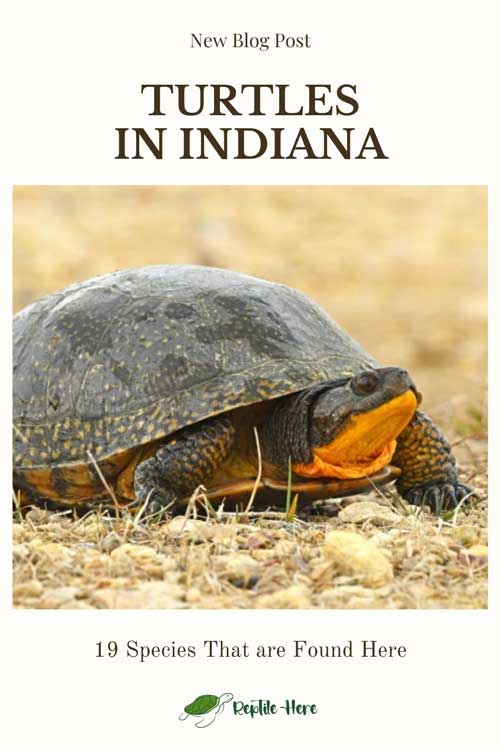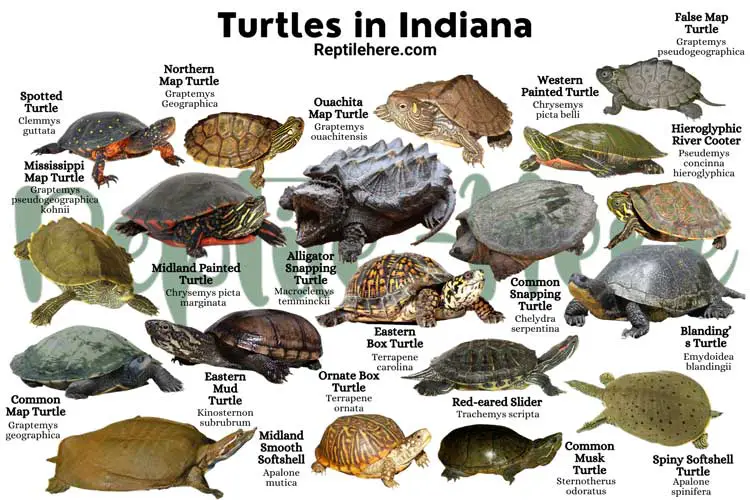Turtles in Indiana – 19 Species That are Found Here
Indiana is home to 19 species. These species range from aquatic to semi-aquatic, and terrestrial varieties. They include snapping turtles, softshell turtles, map turtles, mud and musk turtles, painted turtles, and box turtles.
Most of these turtles have a conversation status of least concern and will make good pets for the beginner as well as experienced turtle owners.
However, keep in mind that Indiana has strict laws in place prohibiting the sale of wild-caught turtles as a measure to preserve these creatures.
This article will take you through the full list of the species of turtles found in Indiana.
For each turtle species, we’ll focus on basics like physical appearance, average adult size, what they eat, where they live, lifespan, and conservation status.
19 Types Of Turtles in Indiana
Contents
1. Alligator Snapping Turtle
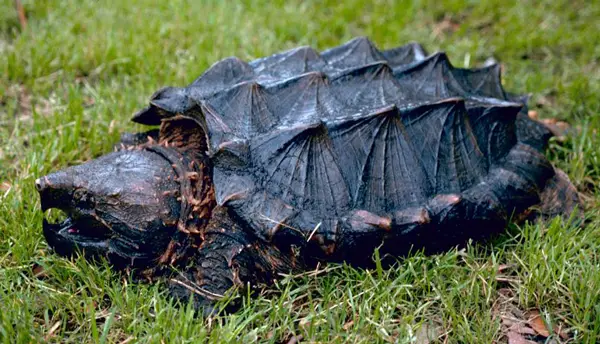
- Scientific name: Macroclemys temminckii
- Common name: Alligator snapping turtle, Snapping turtle
- Family: Chelydridae
- Size: 15 to 26 inches
- Lifespan: 80 to 120 years
- Conservation status: Vulnerable
The alligator snapping turtle is the largest freshwater turtle in Indiana. This species is large than the common snapping turtle. An adult alligator snapping turtle weighs 15 to 20 inches long.
An alligator turtle is characterized by a long, tough shell with trigonal ridges that resemble the back of an alligator (hence the name alligator turtle).
Shell coloring can be black, olive, or brown. Though some people believe that the green tips on the shell ridges are natural, they’re simply algae.
These alligator turtles also prefer living in deeper waters of rivers, canals, lakes, and swamps in Indiana.
As omnivorous species, they hunt their prey (but not actively). They have a unique way of hunting where they lie at the bottom of the water body and open their mouth to show their pink work-like appendage to lure their prey.
And when the prey gets close enough, the turtle ambushes it!
Another interesting fact about this sea turtle in Indiana is its powerful jaws which can bite with a force of up to 1000lbs!
This makes them extremely dangerous turtles and should NEVER be handled in the wild! Mind you, they have injured even the most experienced herpetologists with their bites.
2. Common Snapping Turtle

- Scientific name: Chelydra serpentina
- Common name: Snapping Turtle
- Family: Chelydridae
- Size: 8 to 18 1/2 inches
- Lifespan: 30 to 50 years or more
- Conservation status: Least Concern
Common snapping turtles are widespread throughout Indiana. An average adult is pretty large and has a shell length of 18½ inches long.
This species has a chunky head, a long tail, and large webbed feet. The shell color is black or olive and has no distinct pattern. These Indiana snapping turtles are known for their powerful jaws—they’re so strong that these turtles eat other turtles!
You’ll find them in waterbodies with muddy bottoms. Examples include marshes, ponds, lakes, rivers, and even shallow streams. They generally prefer waters with aquatic vegetation in plenty and foods such as fish, frogs, birds, etc.
These Indiana aquatic turtles generally show docile behavior but can get quite aggressive if taken out of water. The best way to calm it is to take it back to the waters, where it feels safe.
3. Spiny Softshell Turtle
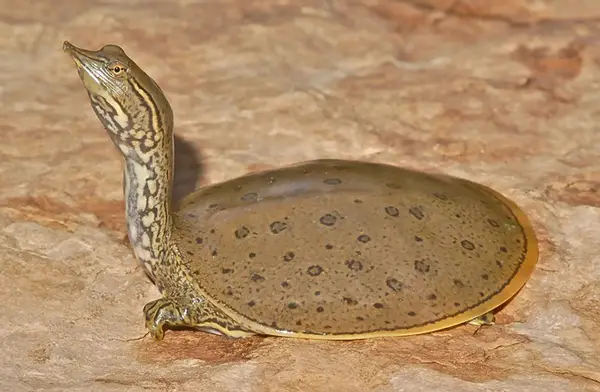
- Scientific name: Apalone spinifera
- Common name: Spiny Softshell Turtle
- Family: Trionychidae
- Size: 5 to 9 inches (males), 12 to 20 inches (females)
- Lifespan: 30 to 70 years
- Conservation status: Least Concern
The Spiny softshell turtle is a medium-to-large freshwater species that live in Indiana’s lakes, streams, and rivers with muddy or sandy bottoms and little or no vegetation.
Female spiny softshell turtles are usually larger than males. And unlike other turtles, this species has a flexible, leather-like carapace that’s extremely rounded and flattened. The shell color can be olive grey or yellow-brown.
Just like other softshell turtles, this species also has a snorkel-like snout.
The young ones feature well-defined round spots that are easily visible on the shell (though these spots become invisible as they transition to adulthood).
Spiny softshell turtles in Indiana tend to eat anything they find in the waters including crayfish, insects, small fish, and so on. They hunt by burying themselves in the mud or sand while keeping their head uncovered to grab food as it swims by.
These turtles are also able to breathe underwater by taking in oxygen through their throat skin. This is a useful adaptation given that they don’t spend a lot of time out of water.
Other adaptations of these turtles include webbed feed, long claws, and extremely flat shells that enable them to quickly swim away from predators and burry in the muddy bottom of the waters they reside in.
4. Midland Smooth Softshell Turtle
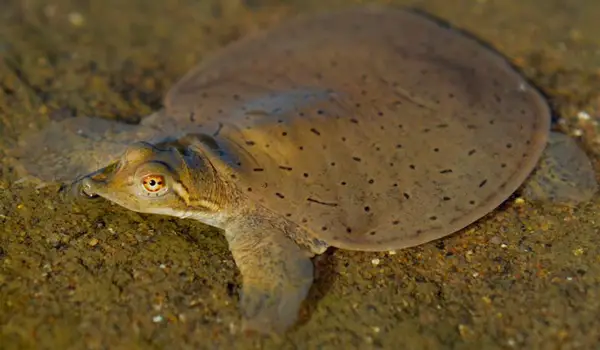
- Scientific name: Apalone mutica
- Common name: Midland Smooth Shell
- Family: Trionychidae
- Size: 6 to 13 inches
- Lifespan: 40 to 60 years
- Conservation status: Least Concern
The midland smooth softshell turtle boasts its position as the fastest turtle on land in Indiana! Though most people believe these turtles are slow-moving, they must be quick to enable them to outrun their predators given that their soft shells don’t offer much protection.
Shell color of this turtle species ranges from olive to dark brown. The upper part of its shell features dark markings (with female markings appearing in a blotchier pattern than the males’)
The shell of these turtles also appears rounder and flatter, just like other softshell species.
Note that Gulf Coast smooth turtle (Apalone calvata) is the closes relative of this Midland smooth softshell turtle. The main difference existing between these two species is size, with the Gulf coast turtle reaching a maximum of 12 inches long.
Also, the Gulf coast species has no lines on its face while the midland smooth softshell turtle does.
These turtles like inhabiting waterbodies like rivers and streams in Indiana that provide an abundance of mud or sand at the bottom. They can also be found in stagnant waterbodies.
Midland smooth softshell turtles are omnivorous and their diet revolves around aquatic vegetation and insects. However, they have been observed to like meat more than plant matter and will mainly eat snails, insects, and fish.
5. Eastern Mud Turtle
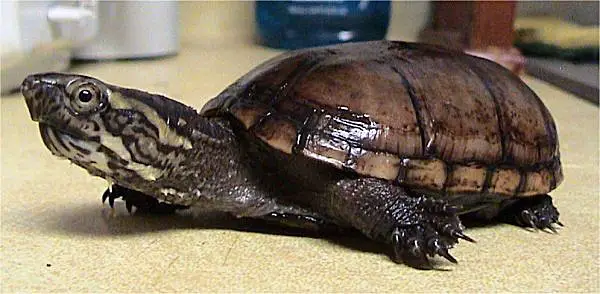
- Scientific name: Kinosternon subrubrum
- Common name: Eastern Mud Turtle, Mud Turtle
- Family: Kinosternidae
- Size: 3 to 5 inches
- Lifespan: 50 years
- Conservation status: Least Concern
The Eastern Mud turtle in Indiana is found in shallow waters including ditches, marshes, wet meadows, and swamps.
This smaller aquatic turtle species is characterized by a smooth and unmarked shell. Yes, it has an incredible plain look, with its upper shell lacking any patterns. The carapace color ranges from dark yellow to black.
The lower side of the shell is also pretty plain, though it usually appears lighter on the upper part. The key distinction of this mud turtle is the stripes on its head which can be white or yellow in color.
One particular feature that sets this turtle apart from others and makes it easily identifiable is the hinges on its lower shell which form a “K” shape when viewed from the sides.
Just as its name suggests, this turtle lives in water bodies with a soft muddy, or sandy bottom. Thus, they can be found in marshes, swamps, and rivers in Indiana.
Since the Indiana eastern mud turtle is omnivorous, it eats meat, fish, snails, insects, and aquatic vegetation as well as plant matter on land.
Unlike other turtles, eastern mud turtles do not hibernate in the cold winter months. Instead, it does the opposite—it becomes dormant in the hot months of summer (this is known as aestivation).
6. Common Musk Turtle
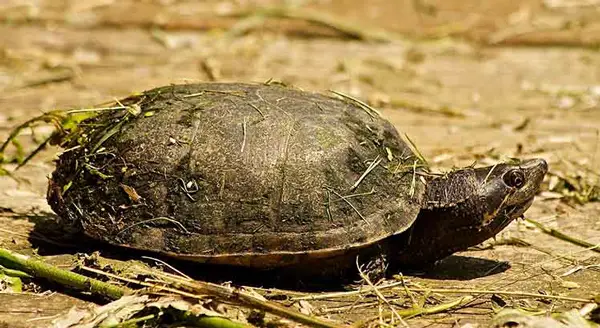
- Scientific name: Sternotherus odoratus
- Common name: Eastern Musk Turtle, Common Musk Turtle, Musk Turtle, Stinkpot
- Family: Kinosternidae
- Size: 2 to 4.5 inches
- Lifespan: 30 to 50 years
- Conservation status: Least Concern
The Eastern Musk Turtle is another aquatic turtle found in Indiana’s slow-moving and sluggish streams as well as still water bodies.
The turtle prefers areas with dark crevices, where it can easily hide. It also prefers lots of plant matter to burrow in and hide.
An average adult eastern musk turtle is quite small (2 to 4.5 inches long). It has a pretty plain appearance with highly consistent colors. Both the shell and skin usually share the same color and can range from dark brown to black.
The turtle shell has one unique feature—a ridge traversing its entire shell length. Besides, it has another distinctive feature: two light-colored stripes on its head.
Common musk turtles of Indiana are herbivorous and will eat small aquatic or semi-aquatic animals, carrion, and aquatic vegetation. They will also feed on any other vegetation on land.
When it feels threatened, this turtle species emits a foul odor (a musky odor, hence its name). This scent can be detected in water or on land. It can also easily waft through the air to its predators.
Also, these Indiana turtles are good at climbing trees! This great capability enables them to go high up tree branches to find a safe resting place and avoid predators.
7. Spotted Turtle
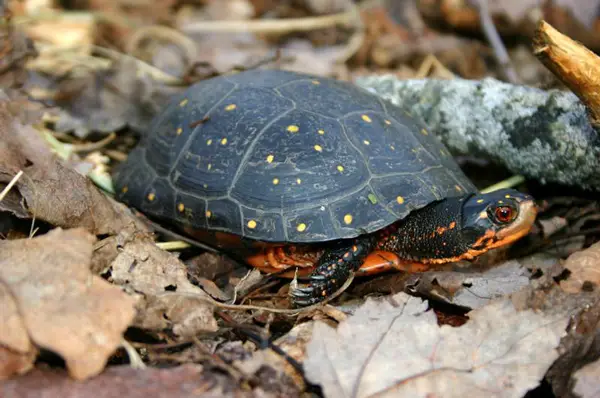
- Scientific name: Clemmys guttata
- Common name: Spotted Turtle
- Family: Emydidae
- Size: 4 to 5 inches
- Lifespan: 25 to 50 years
- Conservation status: Endangered
The Spotted turtles in Indiana reside in shallow marshes, swamps, and bogs. They’re semi-aquatic and are comfortable on land just as they are in the waters.
An adult spotted turtle has a smooth upper shell that ranges from olive to dark brown in color, with some light yellow spots. The neck and head feature irregular orange or yellow spots and streaks. Their tails are fairly long.
The turtles are omnivorous and their diet involves crustaceans, mollusks, insects, and plant matter (occasionally). Note that these turtles are aggressive hunters and will actively seek their prey.
Unfortunately, the population of spotted turtles in Indiana is on the decline due to human interference and habitat loss. Their unique shell patterns make them a favorite species of a pet turtle for many people.
For this reason, they’re listed as endangered and protected by many governing bodies, including Indiana authorities.
Above all, the spotted turtles of Indiana are incredibly smart. Studies carried on them using a maze even indicate that they have the same brain capacity as the mouse!
8. Blanding’s Turtle
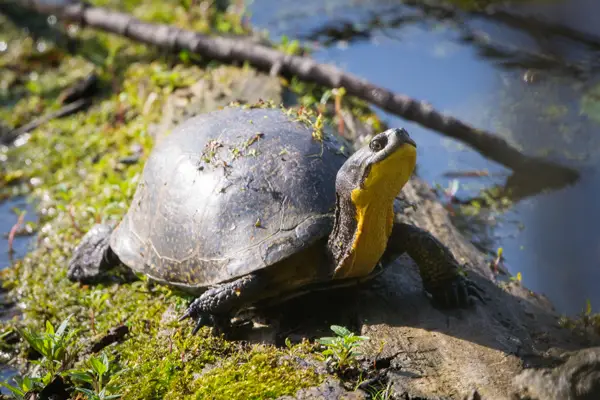
- Scientific name: Emydoidea blandingii
- Common name: Blanding’s Turtle
- Family: Emydidae
- Size: 5 to 8 inches
- Lifespan: up to 80 years (or more!)
- Conservation status: Endangered
Blanding’s Turtle is also known as the “turtle that smiles” and is named in honor of William Blanding, the American naturalist.
The species is semi-aquatic and is categorized under endured species in Indiana. It is mainly concentrated in the northern half of this state, but its population is quite scattered—making it hard to find.
A typical Blanding’s turtle has a dark oval shell covered with faint yellow speckles. The lower side of its shell is usually yellow with black patches.
Blanding’s turtle in Indiana prefers living in marshy habitats. And the fact that it’s losing these favorite habitats is one of the reasons causing its population to decline fast.
Because this turtle species in Indiana is omnivorous, it feeds on leatherworks, crayfish, and aquatic invertebrates. It also occasionally feeds on plants and doesn’t rely on water to help it sallow its food as it’s the case with most turtle species.
Also read: Turtles in Pennsylvania
9. Hieroglyphic River Cooter
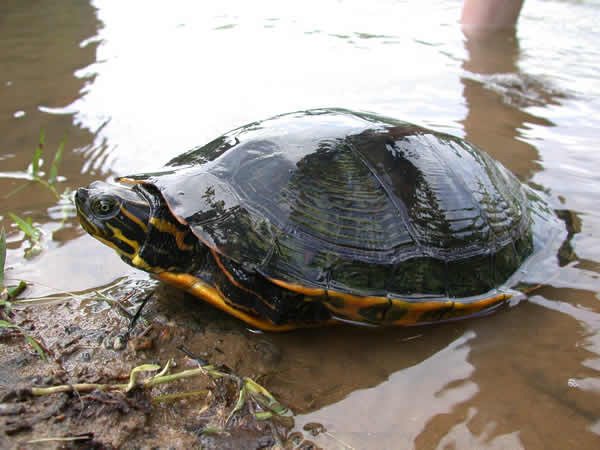
- Scientific name: Pseudemys concinna hieroglyphica
- Common name: River Cooter
- Family: Emydidae
- Size: 8 to 12 inches
- Lifespan: 20 to 40 years
- Conservation status: Least Concern
River Cooter turtles are also inhabitants of Indiana. They’re known to be solitary creatures and often like basking alone in the sun.
However, they can be sometimes observed sharing habitat with painted turtles and red-eared sliders.
They’re distinguishable by their green-brown or black carapace with red or orange patterns resembling hieroglyphics. Their plastron is light colored while the skin is covered with pronounced stripes ranging in color from yellow to orange or red.
Most of these turtle adults are around 8 to 12 inches in size, though it’s not rare to come across females with a bigger size—up to 15 inches.
These turtles are pretty fast both on land and in water. They’re found in various freshwater bodies including lakes, ponds, and rivers in Indiana. They’re also found in brackish water.
Their diet is primarily herbivorous and mainly consists of various forms of aquatic vegetation and land plant matter, including fruits and vegetables. They’re however known to occasionally feed on insects and snails.
10. Western Painted Turtle
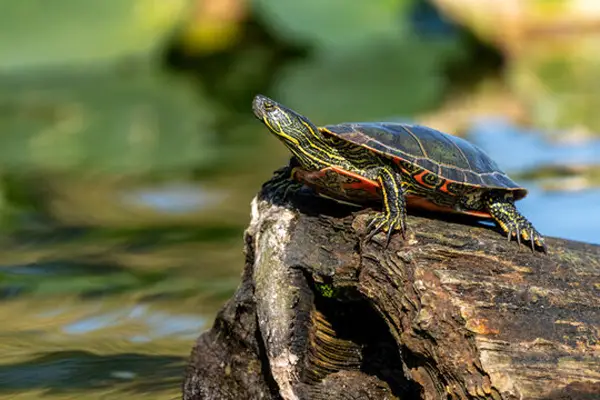
- Scientific name: Chrysemys picta belli
- Common name: Westland Painted Turtle
- Family: Emydidae
- Size: 4 to 10 inches
- Lifespan: 30 to 40 years
- Conservation status: Least Concern
The Western painted turtle is a subspecies of painted turtle and is also found in Indiana waterbodies.
This turtle is identified by an oval-shaped carapace that lacks a ridge in the middle. The carapace is usually dark olive or black in color.
The lower side of the shell is usually red, with multiple dark markings in the center. And the skin itself is covered with yellow stripes.
Westland painted turtles of Indiana are aquatic and their webbed feet help propel them in the waters.
The most common habitats for this turtle in Indiana include slow-moving rivers, shallow streams, and lakes. They choose these areas because they can easily find food.
Given that they’re omnivorous, they feed on aquatic vegetation as well as meat from insects, snails, shrimps, tadpoles, and earthworms.
Their hatchlings are more carnivorous to help take in more proteins for building muscle.
11. Midland Painted Turtle
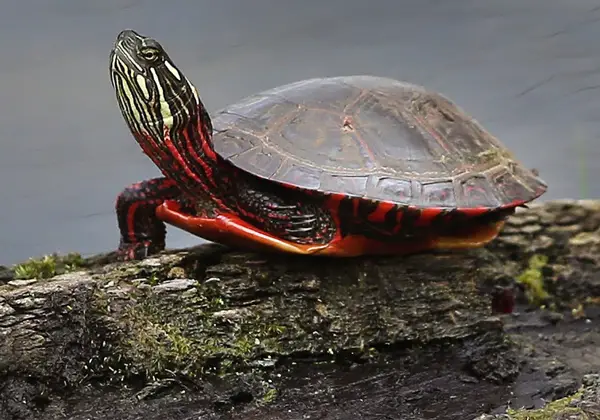
- Scientific name: Chrysemys picta marginata
- Common name: Midland Painted Turtle
- Family: Emydidae
- Size: 4 to 10 inches
- Lifespan: 20 to 40 years
- Conservation status: Least Concern
This is another subspecies of painted turtle you’ll find in Indiana. Telling this specie apart from other painted turtles can be challenging since it lacks any unique features.
Nonetheless, a typical midland painted turtle has a dark-colored shell and skin that ranges from dark brown to black. Its shell usually features markings on its side, with colors from red to yellow.
The lower side of its shell is usually yellow in color. Don’t forget the skin is usually covered with lines than turn yellowish near the head and then change to red.
Just like the other painted turtles, this species prefers living in freshwater bodies in Indiana. It can be found in slow-moving rivers, lakes, and ponds.
They’re also omnivorous and like feeding on aquatic vegetation as well as meat from insects, snails, shrimps, tadpoles, and earthworms.
12. Red-eared Slider
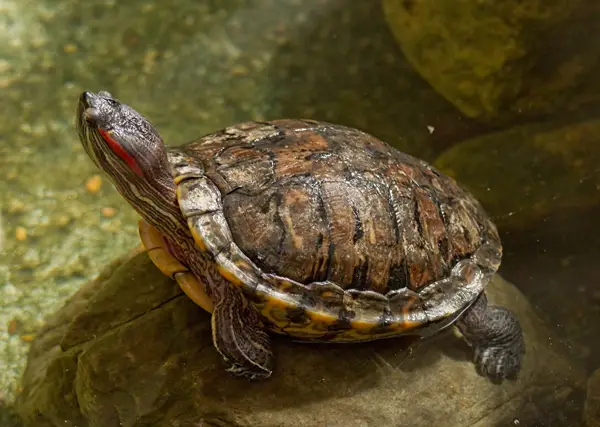
- Scientific name: Trachemys scripta
- Common name: Red-eared Slider, Red-eared Terrapin
- Family: Emydidae
- Size: 7 to 11 inches
- Lifespan: 30 to 40 years
- Conservation status: Least Concern
The red-eared slider is a sub-species of pond sliders and a native species of Indiana. It is a semi-aquatic turtle and prefers living in marshes, ponds, lakes, and creeks.
A red-eared slider gets its name from the small red stripe surrounding its ears (or behind the eye), and its ability to quickly slide off logs and rocks into the water.
Generally, the skin and shell coloration of this slider can be brown or black, with yellow stripes covering the skin.
The red-eared sliders of Indiana are pretty large and the adults reach 7-12 in length (though females are generally larger than males).
These Indiana pond sliders are omnivorous and like eating fish, snails, insects, and aquatic vegetation. They also eat land vegetation, including fruits and vegetables.
13. Common Map Turtle
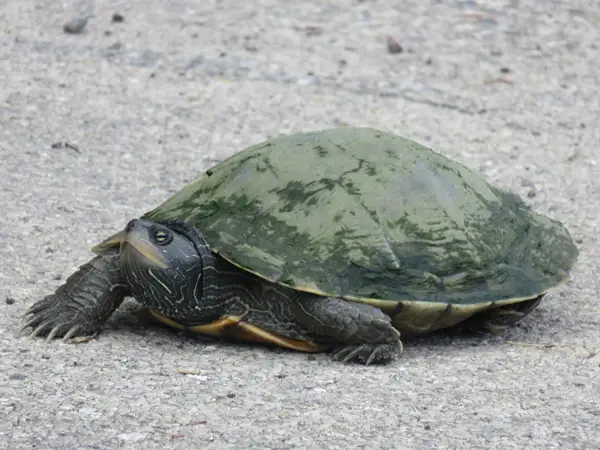
- Scientific name: Graptemys geographica
- Common name: Common Map Turtle, Northern Map Turtle
- Family: Emydidae
- Size: 3 to 10 inches
- Lifespan: 30 to 50 years
- Conservation status: Least Concern
The common map turtle is another species that inhabits Indiana. To be more specie, this freshwater turtle resides in the rivers and lakes of Indiana.
They prefer living in large waterbodies with debris. These offer the perfect spots for basking while the water bodies enable them to spend their hibernation periods in winter completely submerged.
Like other map turtles, this common map turtle gets its name from the map-like pattern on its shell. Its shell is typically darker and ranges from brown to black. The map pattern has a lighter coloration.
The common map turtle of Indiana is mainly carnivorous and feeds on mollusks such as clams and snails. It will also eat crayfish and insects. And when animal matter gets scarce, it will feed on plant matter.
Note that it may be difficult to spot a common map turtle in the wild in Indiana. Although active during the day, these turtles are quite timid and will quickly retreat to the waters at the slightest disturbance.
14. Northern Map Turtle
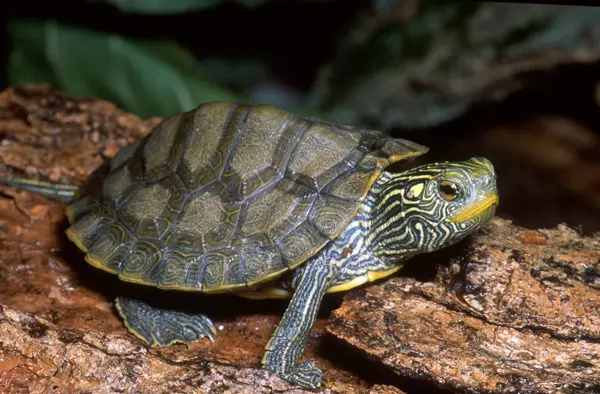
- Scientific name: Graptemys Geographica
- Common name: Common map Turtle, Northern Map Turtle
- Family: Emydidae
- Size: 3.5 to 6.5 inches (males), 7 to 10.5 inches (males)
- Lifespan: 20+ years
- Conservation status: Least Concern
The Northern map turtle also goes by the name common map turtle and was labeled as the second most common Graptemys in 2009. The species is commonly found in ponds, lakes, streams rivers, and drainage systems.
Northern map turtles found in Indiana will simply inhabit any waterbody that provides abundant aquatic vegetation, with deep waters with a stony or rocky bottom.
The turtle gets its “map” name due to the map-like markings covering its olive or grayish-brown upper shell.
On top of this, the shells have orange or yellow lines with dark borders. The carapace is broad and has a low keel. The plastron of an adult common map turtle is yellowish in color.
Most of these turtle species also feature an oval spot behind the eyes.
Northern map turtles in Indiana can be observed basking on the fallen trees around the waters of Indiana while feeding on snails, crayfish, clams, crustaceans, and other aquatic insects.
Since females are larger than males, they tend to feast on bigger prey than males.
15. False Map Turtle
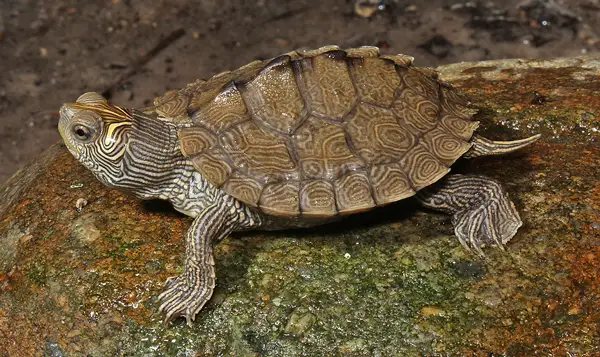
- Scientific name: Graptemys pseudogeographica
- Common name: False Map Turtle, Sawback Turtle
- Family: Emydidae
- Size: 6 to 10 inches (females), 3.5 to 6 inches (males)
- Lifespan: 30 to 50 years
- Conservation status: Least Concern
The False map turtle is another turtle species found in Indiana. This turtle’s preferred habitat in Indiana includes rivers, streams, and oxbow lakes of the Missouri and Mississippi river systems.
It is an excellent swimmer and prefers moderate currents and deep waters.
Its upper shell coloring ranges from olive to dark brown, with light-colored lines on its limbs. It also features a line behind its eye that forms a backward “L” shape. The map pattern on its carapace tends to fade as the turtle ages.
Since this map turtle of Indiana is omnivorous, it feeds on aquatic insects and animals as well as vegetation. It is fond of river snails and crustaceans. Don’t forget it has strong jaws and can give a nasty bite!
Like most of the other aquatic turtles of Indiana, this map turtle spends most of its waking hours sunning.
The false map turtle is quite shy and quietly and swiftly slides into the water at the slightest signs of disturbance. It likes spending most of its time in water and is most active in climate conditions of over 85 degrees Fahrenheit.
16. Mississippi Map Turtle
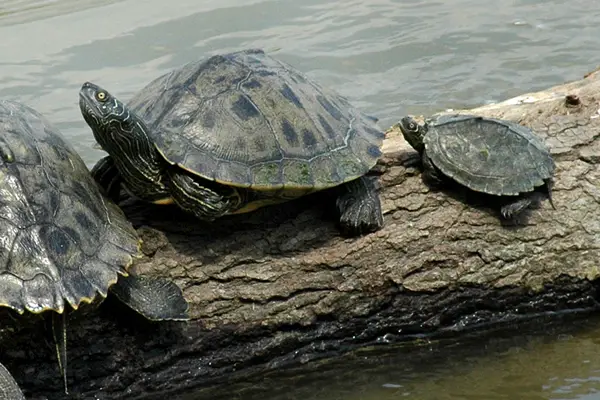
- Scientific name: Graptemys pseudogeographica kohnii
- Common name: Mississippi Map Turtle, Map Turtle
- Family: Emydidae
- Size: 3 to 5 inches (males), 8 to 10 inches (females)
- Lifespan: 30 to 50 years
- Conservation status: Least Concern
The Mississippi map turtle is also found in Indiana. It gets its name from Mississippi Valley, the area where the species are widespread.
This map turtle of Indiana has its upper shell with olive green or brown color, while the scutes feature a brighter color and are covered with patterns resembling a map.
The underside of the shell of this turtle is usually tan or yellow and has darker brown stripes.
You’ll find this turtle in Indiana in slow-moving or stagnant waters with plenty of vegetation to act as their source of food. The most common habitats include slow-moving streams, rivers, ponds, and lakes.
Since these turtles of Indiana are omnivorous, they’ll eat meat, insects, vegetables, fruits, and aquatic vegetation, to name but a few.
Note that a Mississippi map turtle of Indiana makes a perfect turtle for a beginner turtle owner.
17. Ouachita Map Turtle
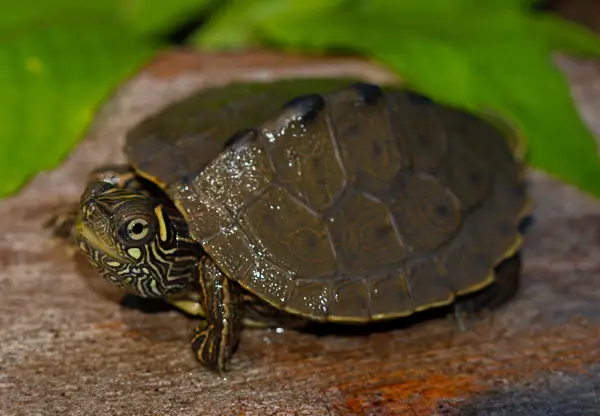
- Scientific name: Graptemys ouachitensis
- Common name: Ouachita Map Turtle, Map Turtle
- Family: Emydidae
- Size: 3 to 5 inches (males), 8 to 10 inches (females)
- Lifespan: 30 to 50 years
- Conservation status: Least Concern
The Ouachita map turtle lives in the swift rivers and streams forming the Mississippi River and its tributaries in Indiana.
It is regarded as one of the less popular map turtle species. The turtle makes an excellent choice of pet for many people since it’s easy to care for.
As for its name, this species is named after the river where it was discovered—Ouachita!
Ouachita turtle is medium to large in terms of size. The average adult female is 3-5 inches long while the male is 8 to 10 inches long. It features thin, yellowing lines that form a web on the turtle’s shell (similar to a contour elevation map).
Moreover, the turtle has brown to olive coloring, with a light spot under both eyes.
The easiest way to identify this Indiana turtle species from other map turtle subspecies is by checking the dots on its face. They usually have 3 prominent spots—under the jawline, under the eye, and behind the eye.
Note that this turtle prefers living in stagnant or slow-moving waters, including ponds, lakes, and streams in Indiana.
It also prefers waters with plenty of vegetation. This species is omnivorous and eats meat, insects, vegetables, fruits, aquatic vegetation, etc.
18. Eastern Box Turtle
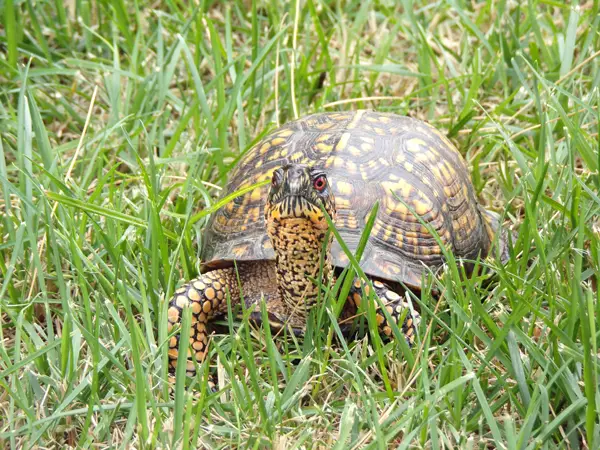
- Scientific name: Terrapene carolina
- Common name: Eastern Box Turtle, Land turtle, Box Turtle
- Family: Emydidae
- Size: 4.5 and 7 inches
- Lifespan: 50 to 100 years
- Conservation status: Vulnerable
The eastern box turtles of Indiana are found in dense thickets and woodland areas. They prefer these areas due to abundant access to sunlight and food sources nearby.
An adult turtle of this species is about 4.5 to 7 inches and weighs just 2lbs. It has a high, domed shell shape with a ridge running from head to toe. The shell of this turtle has varying colors of olive, brown, and tan.
The variation in markings on the shells of these turtles is so variable that you can’t easily recognize one by looking at the shell alone.
These eastern box turtles of Indiana are omnivorous and feed on a variety of foods including insects, meat, fruits, vegetables, and various types of vegetation.
Note that eastern box turtles are taken from the Indiana wild for pet trade, leading to a decline in their population. For this reason, many states have illegalized capturing and selling of this species.
And those in captivity end up dying due to poor conditions or being abandoned or released back into the wild because they’re too demanding to maintain.
19. Ornate Box Turtle
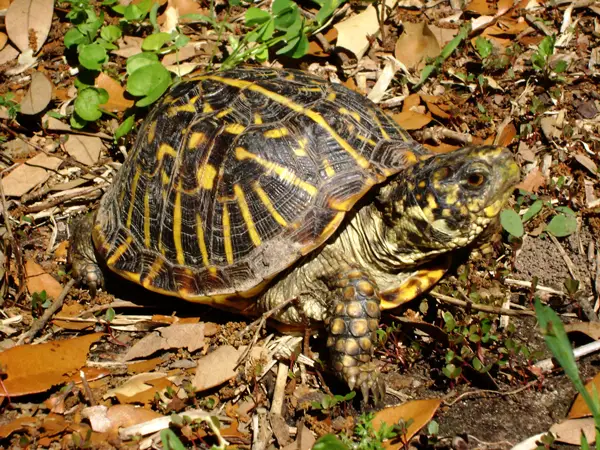
- Scientific name: Terrapene ornata
- Common name: Ornate Box Turtle
- Family: Emydidae
- Size: 5 to 7 inches
- Lifespan: 40 to 60 years
- Conservation status: Near Threatened
Ornate box turtles are present in Indiana and are recognized by the beautiful pattern on their carapace. This eye-pleasing pattern is sometimes referred to as a starburst pattern.
Their skin is grey and may feature yellow or white spots. Male heads occasionally feature a green color.
Though there exists little distinction between the males and females of these Indiana box turtles, the males are generally smaller than the females.
During hot weather, this turtle requires water to help regulate its body temperature.
The Indiana species of turtle are known to hibernate in burrows during cold weather. They’re also capable of surviving in frozen soils for several days.
There have been observations of them eating grasshoppers, fruits, vegetables, and other insects.
Also, these box turtles are pretty shy and don’t like being handled excessively. As such, you may want to avoid approaching them suddenly while in the wild in Indiana.
Related: Turtles in Tennessee
Conclusion
We have just covered the 19 different species of turtles found in the state of Indiana. These include snapping turtles, softshell turtles, map turtles, mud and musk turtles, painted turtles, and box turtles.
Remember, Indiana has strict turtle laws that make it illegal to sell wild-caught turtles. This is a great measure to help preserve the population of the turtles in the region.
Nonetheless, most of the turtles in this state will make good pets for the beginner as well as advanced turtle owners.
With the info we have provided about each species, you can now easily decide which turtle will make a good pet for you.
